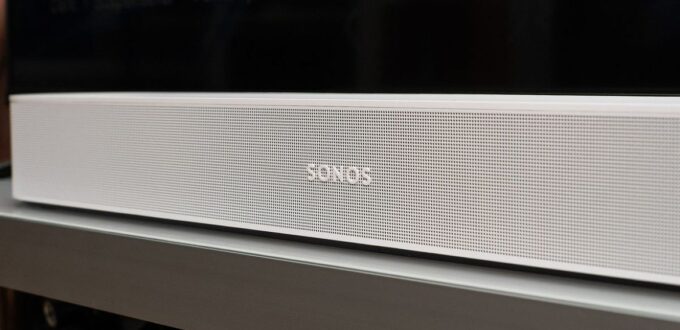Sonos’s original beam gave up with how many audio home theater packed into the small trail, and now the beam (Gen 2) added Dolby atmos into the mixture. It’s a bit more expensive at $ 449, and much smarter inside, this new beam saw Sonos double-do-do-do down to target an audience that wants surround sound but doesn’t want to be surrounded by the speaker. There, with some qualifications, the soundbar was centralized.
Because the original beam was launched, of course, Sonos released a bow. Bigger, harder, and more expensive, the bow also utilizes complete SONOS S2 platform to add Dolby Atmos support. It is something that previous products do not have bandwidth and processing power to support.
S2 transition does not cause a small amount of headaches for Sonos, but it is difficult to argue that it is not feasible. In addition to the support of Atmos, there are also high definition audio streaming and more headrooms for the company’s future features.
Like a bow, a new beam has a plastic grille with thousands of small holes, not a cloth cover from the original soundbar. You might not see the difference from the sofa opposite the room, but must make it easier to clean the dust. It’s just 26 inches wide, and still comes in a white or black matte; The touch sensitive control panel for volume, rotate / pause, trajectory leap, and mute microphone above.
The back of the back port too: power, ethernet, and HDMI. The latter now supports EARC HDMI and a bow; You don’t need an EARC for Dolby atmos, but bandwidth is bigger than the bow connection. That means the quality of the better overall audio is possible, but many streaming providers still use a compressed atmos so depending on your source might not make a lot of differences.
The setting is equally easy with the Sonos product, and the new beam now has a NFC chip – just to the left of the control panel – so you can tap the phone that supports NFC there and has a link to your network that is made faster. If you have a TV recently, all integration must be handled by HDMI-CEC, so that your TV remote can control the volume of the beam. Or, there is an IR option that you can go through in the Sonos application.
Finally, there is TruePlay. Sonos audio tuning system promised Finesse EQ to fit the acoustic nature of the room. To do that, you need to walk around the room with an iPhone detained, as a series of bleeps and bloop that vaguely made the feel of the mid-2000 conceptual art installation. That is, assuming you do not use the iPhone 13, which – at the time of writing has not been supported by TruePlay.
Sonos does have automatic TruePlay in portable movements and Roam speakers, but the electric powered model is fixed with the regular version. The company’s argument is that telephone-based TruePlay has better results than using its own internal speaker microphone, and I would say you can see a little but worthy difference in post-trueplay-tuning audio balance. However, it will be good for those who use Android – or who do not go to the effort to run through a two-minute TruePlay process – if the beam can fall back automatically.
As for what is actually set, even though the addition of Dolby Atmos supports hardware inside does not change. You still get middle tweeters, four middle woofers, and three passive radiators, plus class-D digital amps to drive them. It’s like in the original beam.


No Comments Yet